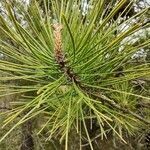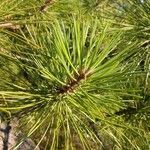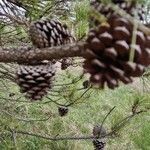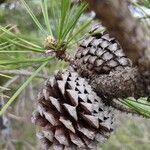Trees to 30 m tall; trunk straight or crooked, to 0.9 m d.b.h. in native range, usually with adventitious sprouts; bark red-brown, with deeply and irregularly oblong, flat, scaly ridges; crown rounded or irregular; 2nd-year branchlets orange-brown, aging darker brown, stout, mostly more than 5 mm wide, rough; winter buds red-brown, ovoid or ovoid-cylindric, resinous, scales fringed at margin. Needles 3(-5) per bundle, deep or pale yellow-green, twisted, 5-10(-15) cm × 1-1.5(-2) mm, stomatal lines present on all surfaces, base with persistent sheath 0.9-1.2 cm. Seed cones often clustered, sessile or shortly pedunculate, dull brown or pale red-brown, conical or ovoid before opening, broadly ovoid with flat or slightly convex base when open, 3-9 cm, maturing in 2 years, dehiscent. Seed scales with dark red-brown border adaxially distally; apophyses rhombic, slightly raised, strongly cross keeled; umbo low pyramidal, with a slender, reflexed prickle. Seeds dark brown, mottled darker or nearly black, broadly obliquely obovoid-deltoid, 4-6 mm; wing 1.5-2 cm.
Tree to 20 m, with spreading, irregular branches; bark dark and very rough; twigs brown; terminal buds ca 1.5 cm, their scales chestnut-brown, fringed, resinous; lvs mostly in 3’s, persisting 2–3 years, stiff, dark green, 7–12 cm × ca 2 mm; cones divergent, conic-ovoid, 4–7 cm, long-persistent but generally opening at maturity; apophysis thickened and somewhat elevated, the umbo elevated and with a slender spine 1–3 mm; seeds ca 1.5 cm. Dry, rocky or sandy soil; s. Me. to s. Que. and s. Ont., s. to n. Ga., and with outlying stations in c. and w. Ky.; dominant on the pine-barrens of N.J., but seldom on the coastal plain farther south.
A pine tree.






